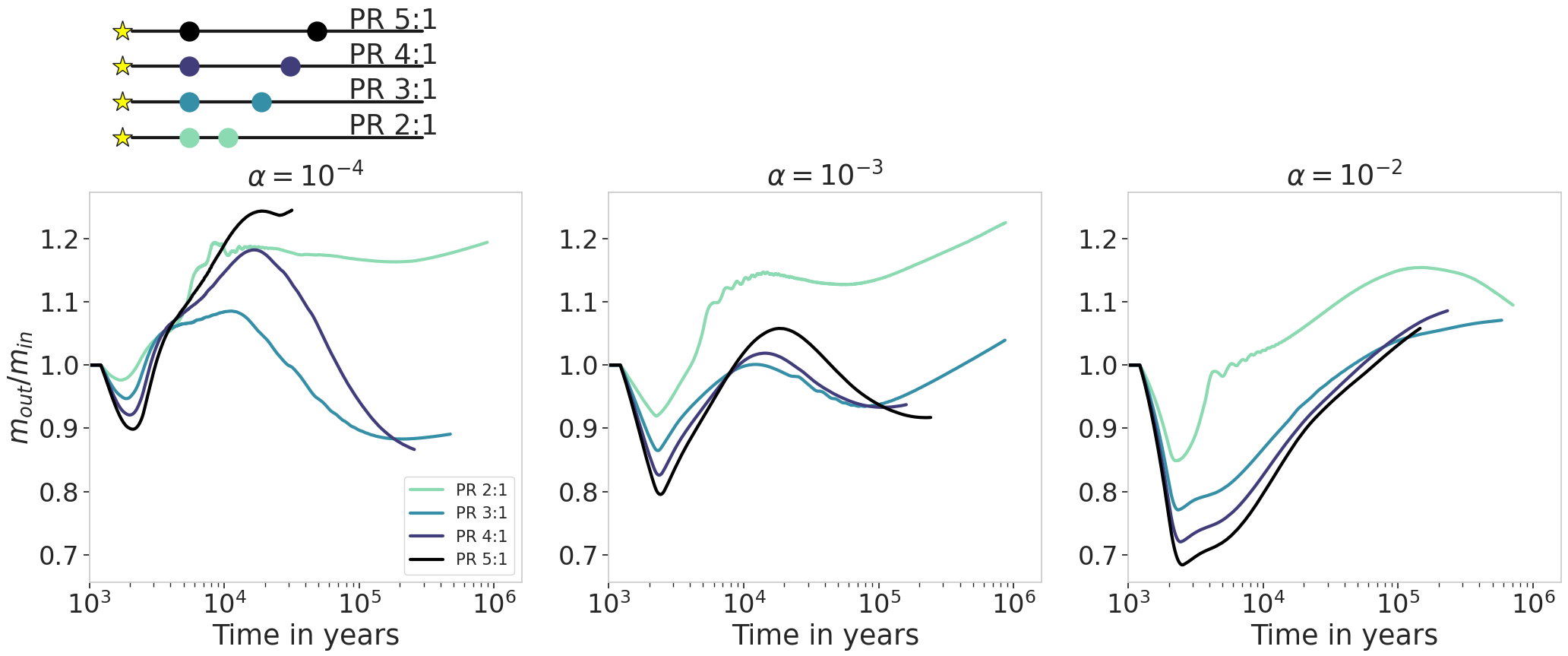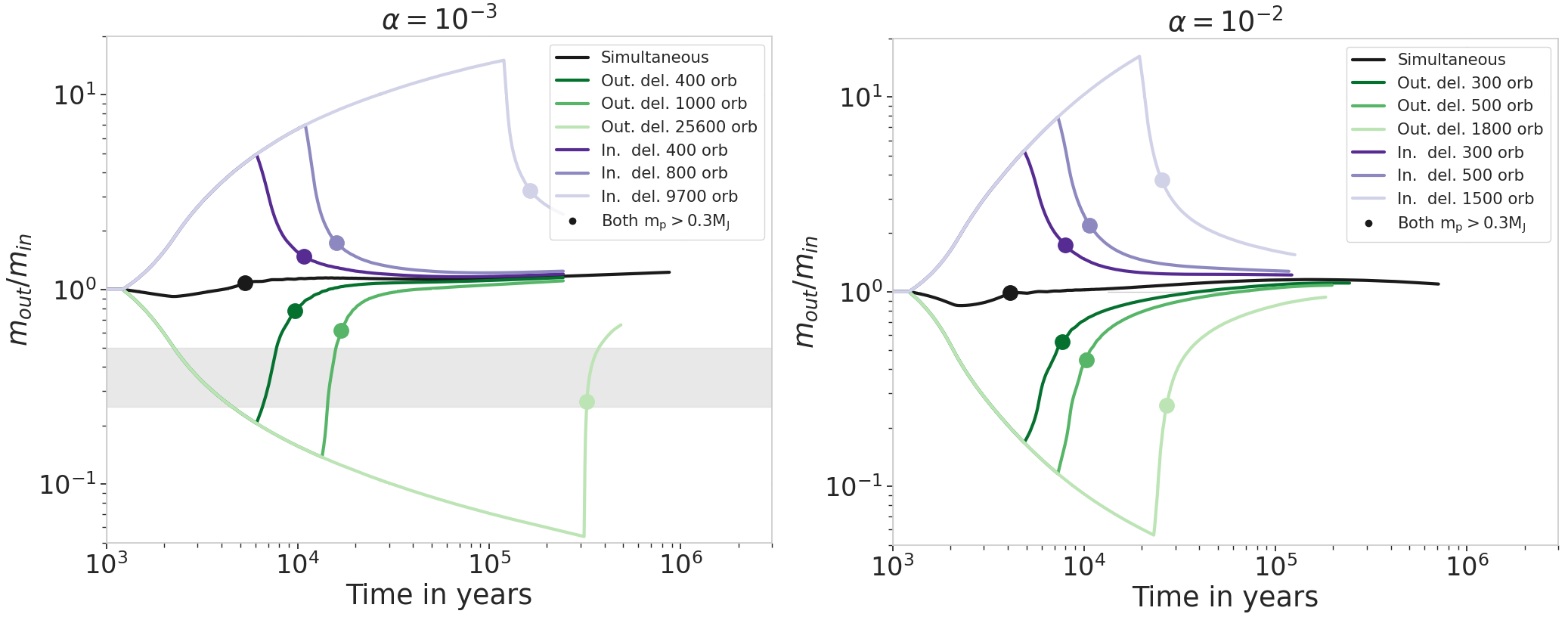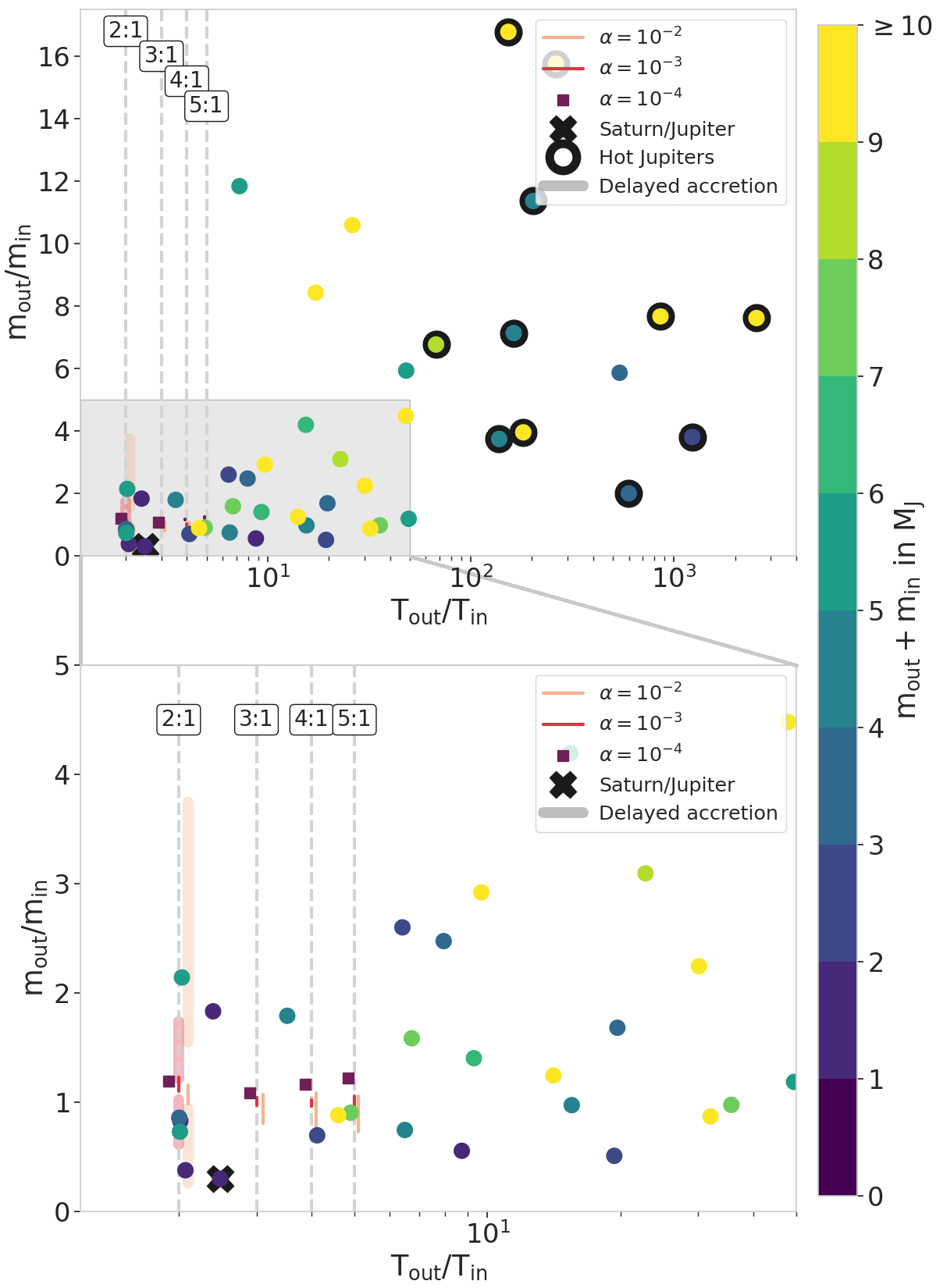Simultaneous gas accretion onto a pair of giant planets: Impact on their final mass and on the protoplanetary disk structure
C. Bergez-Casalou, B. Bitsch, S.N. Raymond
Jan. 2023 - published in A&A - arxiv:2211.16239
Paper Abstract
Several planetary systems are known to host multiple giant planets. However, when two giant planets are accreting from the same disk, it is unclear what effect the presence of the second planet has on the gas accretion process of both planets. In this paper we perform long-term 2D isothermal hydrodynamical simulations (over more than 0.5 Myrs) with the FARGO-2D1D code, considering two non-migrating planets accreting from the same gaseous disk. We find that the evolution of the planets' mass ratio depends on gap formation. However, in all cases, when the planets start accreting at the same time, they end up with very similar masses (0.9 < mp,out/mp,in < 1.1 after 0.5 Myrs). Delaying the onset of accretion of one planet allows the planets' mass ratio to reach larger values initially, but they quickly converge to similar masses afterward (0.8 < mp,out/mp,in < 2 in 105 yrs). In order to reproduce the more diverse observed mass ratios of exoplanets, the planets must start accreting gas at different times, and their accretion must be stopped quickly after the beginning of runaway gas accretion (less than 0.5 Myrs), for example via disk dispersal. The evolution of the planets' mass ratio can have an important impact on the dynamics of the system and may constrain the formation history of Jupiter and Saturn.
Context and setup
In the core accretion scenario for planet formation, gaseous giant planets go through two phases of accretion: a first slow accretion phase, where they start
building an atmosphere arround them, until this atmosphere becomes massive enough and collapses on itself. The planet starts to accrete even more gas
which collapses even more. In this last stage called the runaway gas accretion phase, the planet is growing mostly by accreting gas.
Previous studies have investigated this accretion process on single planets. However, when we look at the structure of exoplanetary systems, or even in our
own Solar System, we see that a single disc can form multiple giant planets. In this work, we study how the gas in the protoplanetary disc is distributed
when two giant planet cores start to accrete gas from the same disc. To achieve this goal, we run hydrodynamical simulations with the FARGO2D1D code
for more than 0.5 Myrs. As we are interested in the impact of the presence of a second core on the runaway gas accretion process, we fix both cores in the disc
(i.e. no migration nor dynamical interactions allowed yet. We are currently investigating the impact of the dynamics in a follow up study). As the distance between
the planets might have an important impact on the accretion process, we investigate 4 different configurations for the planets, corresponding to 4 different
period ratios (as they are not dynamically evolving, we use the term "period ratio" instead of "resonance"):

The inner planet is always fixed at the same distance (5.2 AU), while we move the outer planet further and further away. The range of the 2D disc grid is shown in black in the above plot, and all the distances are to scale based on the star to inner planet distance. The 2D gris is larger for the two furhtest positions of the outer planet to make sure that they are far enough from the 2D-1D boundary. Our goal is now to understand how the mass is distributed between the two growing giants.
Initially: We assume that their cores are already formed and are 20 Earth masses each so that they accrete in the runaway gas accretion phase. First we consider simulations where the planets start accreting simultaneously, then we introduce a delay on the start of accretion of the inner or outer planet compared to its companion. The planets are placed in discs with different parameters such as different alpha turbulent viscosity or different aspect ratios.
Output: We monitor the distribution of the gas between the planet by looking at the evolution of the planets' mass ratio as a function of time. Arbitrarily, we choose to look at the ratio between the outer over the inner planet mass. We finish
comparing the obtained mass ratios to the ones observed in exoplanetary systems.Main results - Simultaneous accretion
When the planets start accreting simultaneously, even if the evolution of the mass ratio differs with the alpha viscosity, the planets always end up with similar masses. In the following plot, we show the evolution of the mass ratios for the 4 different period ratios and 3 different alpha viscosity investigated.

At high viscosity (right panel), the mass ratios flip once at around 2 000 years, and then keep increasing as the outer planet accretes more than the inner one. When the viscosity is lower (middle and left panels), the mass ratios flips twice due to the importance of gap opening at these viscosities. However, in all simulations, the mass ratios keep between 0.7 and 1.2 approximately, even after 0.5 Myrs of integration.
Main results - Delayed accretion
In order to determine if the small extend of the mass ratios is due to the simultaneous accretion time, we delay artificially the accretion onto one of the planets. Arbitrarily, we chose 6 different delays, based on the mass reached by the companion (equivalent to fixing the initial mass ratio). First, we delay the accretion on the outer planet and let it start accreting once the inner reaches 0.3 Mj, O.5 Mj or 1Mj. Then, we delay the accretion of the inner planet and procede the same way: the inner planet starts accreting once the outer planet reaches 0.3 Mj, O.5 Mj or 1 Mj. This results in the following mass ratio evolutions. In green, the outer planet is delayed while in purple, the inner one is. For comparison, the simultaneous accretion case is shown in black. Here, we decided to look at the closest period ratio, 2:1, at 2 different viscosities.

By construction, at the beginning of the simulations, the mass ratios are extrem. However, as soon as the companion starts accreting, the planets goes back to a mass ratio close to one. In both cases, in less than 100 000 years, the planets are back again with a mass ratio ranging from 2 down to 0.7. As this looks particular, we look at the mass ratio in the exoplanetary systems that we observe, to see if most of the times, the giants present in the same system indeed have similar masses or not. This is what we show here:

By browsing in the NASA Exoplanet Database, we select the planetary systems hosting exactly 2 observed giant planets (mp > 0.3 Mj), orbiting Sun-like stars. Their mass ratio and period ratio is calculated to compare with our own simulations. The total mass of the system is represented by the colorbar. Our different period ratios are marked by the vertical dashed lines. We add Saturn and Jupiter, represented by the cross. Some of these systems host Hot Jupiters (i.e., giants very close to their star with a period smaller than 10 days): as these planets might have been subject to an efficient inward migration which we do not model here, we will ignore them in our comparison and focus on the planets closer to each others (in the gray aera). On the lower panel, we show how our simulations compare to the distribution of exoplanets: in order to represent the evolution of the mass ratio of the planets, we represent our accreting cores by the vertical lines of different colors. These lines show the extent of the mass ratio reached in the simulation, once both planet are considered giants (i.e., when both planets have a mass > 0.3 Mj). The delayed accretion cases are shown with the thick lines. While we see that our simultaneously accreting planets cannot explain the diversity of the exoplanet mass ratios, we see that the delayed accretion might be sufficient. However, the accretion onto the planets must be stopped early after the beginning of the runaway accretion phase in ordre to explain the majority of the planet mass ratios.
Main consequences
Constraining giant planet formation : in order to explain the diversity of observed mass ratios in exoplanets, we need to stop the accretion onto the giants quickly (< 100 000 yrs) after the beginning of the runaway gas accretion phase or to have very large delays in the accretion process. This can be used to time the gas accretion processes in the formation history of giant planets. Impact on dynamics : the dynamical evolution of planets depends on their mass ratio. For example, the Grand Tack scenario, where two giants start migrating outward, requires a specific mass ratio that is hardly reachable when the planets start accreting simultaneously in the same disc. We are investigating the impact of the simultaneous accretion onto the dynamical evolution of the planets but these results show that processes like outward migration are less probable than expected due to the similarity in mass of the planets.